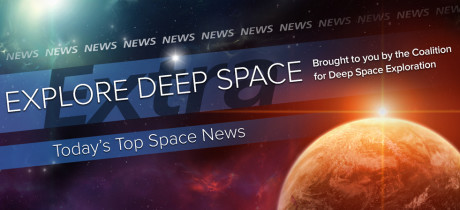In Today’s Deep Space Extra… NASA and its contractor teams address the challenges of developing, producing and launching the hardware that will re-start the human exploration of deep space. The Hubble Space Telescope has overcome gyroscope issues and is once again engaged in space observations.
Human Space Exploration
A bright future for SLS production
Coalition Member in the News – Boeing
SpaceNews.com (10/25): At Boeing, John Shannon is leading the development of the Space Launch System (SLS) crew stage, the foundation of the rocket that is to start humans on future missions of deep space exploration. Recently, NASA’s inspector general raised technical and cost concerns about SLS development and impacts on the first test flights. Many of those concerns had already been addressed when the report was issued, notes Shannon in an op-ed. “We are making great progress towards delivery of the first core stage and at the same time setting the stage for a robust production capability to efficiently build future core stages for later flights,” writes Shannon. “In doing this, we acknowledge that while schedule is always important, safety is always the first priority. We absolutely will not take short cuts on the first rocket or any of those to follow.”
Delving deeper into the KSC processing flow for SLS and Orion ahead of EM-1
Coalition Members in the News – Lockheed Martin, Northrop Grumman, United Launch Alliance
NASAspaceflight.com (10/26): The launch of NASA’s Exploration Mission-1 (EM-1), the first joint test flight of the Space Launch System (SLS) and Orion crew capsule, both part of a U.S. strategy to resume human deep space exploration, is planned by mid-2020. There are a number of ground processing steps through which the hardware must come together at NASA’s Kennedy Space Center (KSC).
Spaceflight might expand your mind, but it shrinks your brain
Space.com (10/27): Researchers from Germany, Belgium and Russia report finding physical changes in the brains and circulation of cerebrospinal fluids in cosmonauts who were studied before and after long spaceflights, according to findings submitted to the New England Journal of Medicine. What the changes mean, however, is unclear. Ten cosmonauts assigned to lengthy missions to the International Space Station (ISS) were studied.
Space Science
Hubble resumes observations after gyro repaired
SpaceNews.com (10/27): The nearly 30-year-old Hubble Space Telescope is once again making science observations after ground teams resolved a problem with one of the observatory’s six gyroscopes, NASA announced on Saturday. The gyro issue surfaced October 5. With three working gyros, Hubble can be pointed and steadied for normal science operations.
The surprising coincidence between two overachieving NASA missions
NASA (10/26): Two ground breaking and long running NASA planetary Science missions, Dawn and Kepler, are nearly out of fuel. Launched in 2007, Dawn is the first spacecraft to orbit an object between Mars and Jupiter and the first two orbit two destinations, Vesta and Ceres, the latter of which appears to be geologically active minor planet. Kepler’s search for planets beyond the solar system points to the possibility that every star in the Milky Way has at least one planet. Kepler was launched in 2009. Both missions have overcome difficulties with reaction wheel aiming mechanisms.
Hayabusa2 braces for a rocky landing on asteroid Ryugu
Space.com (10/27): Japan’s Hayabusa2 asteroid sample return mission to the asteroid Ryugu will attempt to land and collect a sample no earlier than January of next year, according to a Japan Aerospace Exploration Agency news conference hosted by the American Astronomical Society’s Division for Planetary Sciences (DPS). More reconnaissance or Ryugu is planned, and the samples are to be returned to Earth for a descent into Australia and recovery in 2020.
Shanghai company launches world’s first gene bank into space
ChinaDaily.com (10/26): Shanghai based Marvel Tech succeeded Thursday in launching a Chinese gene bank into Earth orbit using a Long March 4 rocket.
Other News
Pentagon official predicts “exciting and interesting” congressional debate on Space Force in 2019
SpaceNews.com (10/26): The White House plans to seek formal authorization from Congress in February to establish a sixth branch of the military, the U.S. Space Force, as part of the 2020 federal budget request, Stephen Kitay, deputy assistant secretary of defense for space policy, told the American Astronautical Society’s Wernher von Braun Memorial Symposium last week.
Pakistan seeks China’s help in sending human to space by 2022
CTGN-TV (10/27): China has agreed to help Pakistan launch its first astronaut, probably in 2022. The pledge has sparked reports of a space race between neighboring Pakistan and India.
Rocket carrying 1st UAE-made satellite launched from Japan
Associated Press via ABC News (10/29): Two Earth observation satellites, KhalifaSat, made in the United Arab Emirates (UAE), and the Japanese Ibuki-2, were launched atop a Japanese H-2A rocket on Monday from the Tanegashima Space Center.
Landspace fails to reach orbit with milestone private Chinese launch
SpaceNews.com (10/27): The first attempt by China’s private sector to commercially launch a small payload, a broadcast satellite, failed early Saturday. The loss was attributed to the third stage of the Zhuque-1 solid fuel rocket.
Major Space Related Activities for the Week
Major space related activities for the week of October 28 – November 3, 2018
Spacepolicyonline.com (10/28): Lots of global space policy and science sessions are planned this week. On Wednesday, NASA news briefs on Mars InSight, the Mars lander planetary science mission on course for a November 26 touchdown. InSight was developed to study the Martian subsurface.

